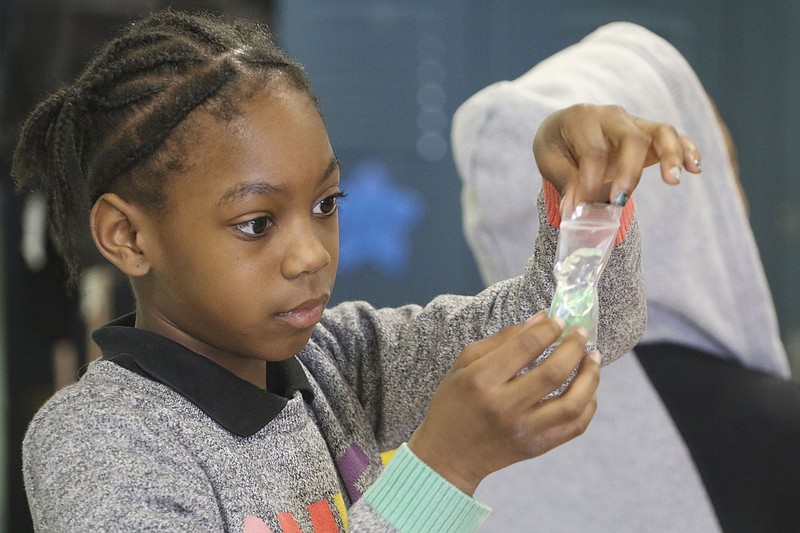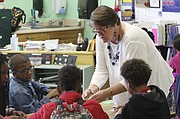Photo Gallery
Hamilton County's Science Sparks pilot program provides teachers, students with hands-on projects
Susan Dorsa walked around her fourth-grade classroom Tuesday squirting clear hair gel into tiny ziplock bags her Barger Academy students eagerly held out.
"What does the gel represent?" she asked.
"Cytoplasm," the class shouted in unison.
The hair gel and ziplock bags were just a few of the supplies the kids used to make plant cells. The bag served as the cell membrane, and a piece of bubble wrap was placed into each bag to represent the cell's vacuole. Different colored beads were the nucleus and mitochondrion, and small strips of green ribbon represented the chloroplasts.
This project is just one of many Dorsa's class is doing for nine weeks as a part of Hamilton County Schools' Science Sparks pilot program.
Dorsa and a small team of teachers spent three days writing the hands-on science curriculum, and then 80 teachers across the district received two training sessions on how to use it.
"Students need the scientific experience to be hands-on," Dorsa said, noting how engaged her students were while making the plant cells.
Teachers involved in Science Sparks were given two large plastic tubs with everything they needed to teach the lessons.
"We put the supplies they need right in their hands," Dorsa said. "They don't have to go buy anything."
Jill Levine, chief academic officer for the school system, said the pilot program perfectly aligns with the district's strategic plan, which places an emphasis on student engagement.
"This is what we should be doing in all schools, as it makes learning rich and meaningful," Levine said.
The depth of explanation that kids are receiving about science concepts like friction, magnetism and animal and plant cells is impressive, she added.
The district wants to expand Science Sparks beyond just fourth grade, developing curriculums for more elementary grades and extending it for the whole school year. But the obstacle standing in the way is funding, Levine said. The Footprint Foundation provided $40,000 to fund the supplies needed for the pilot.
About 60 Hamilton County teachers also received their first round of training Tuesday night for a sister pilot called Cue the Artist, which provides second-grade teachers with the supplies needed to do a nine-week art course. The Footprint Foundation provided another $20,000 for that program.
Several students in Dorsa's class Tuesday said science was their favorite class.
"I like to make cool things," said Jeannyia Phillips. "That's what we do here."
Jeannyia shared a table with classmate Ronald O'Neal, and both carefully played with their plant cells, moving the different parts around in the hair gel - referred to in class only as cytoplasm.
"See, the cytoplasm makes the things inside the cell float," Jeannyia said.
After completing the plant cells, the kids got out their science notebooks and made a key for each part of the cell so they could go back and review it before the state's standardized test later this spring.
Ronald copied what Dorsa wrote on the board onto page 78 of his notebook, saying each word aloud as he wrote it with a bright green pencil.
As he finished he held his cell up to the light.
"I'm going to look at this a lot," he said.
Contact staff writer Kendi A. Rainwater at krainwater@timesfreepress.com or 423-757-6592. Follow her on Twitter @kendi_and.

